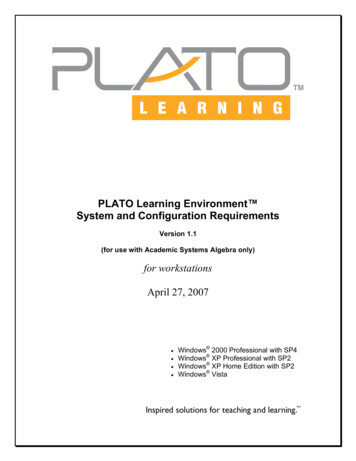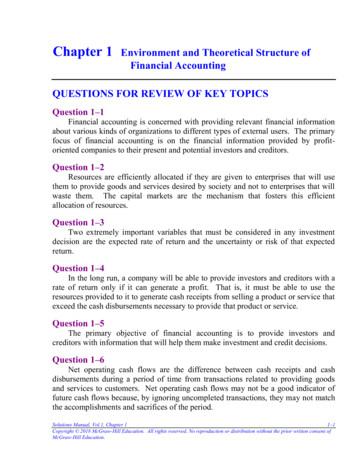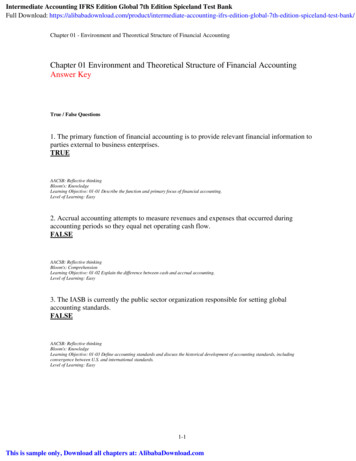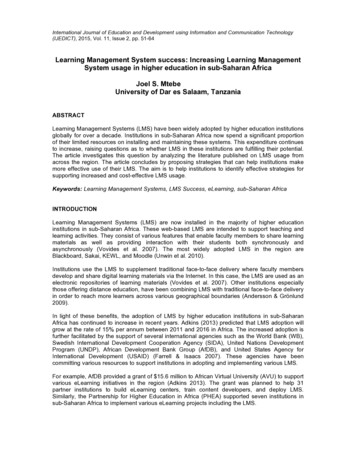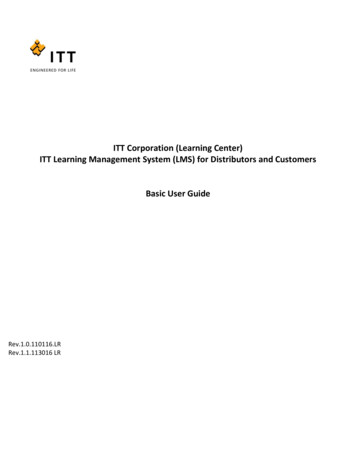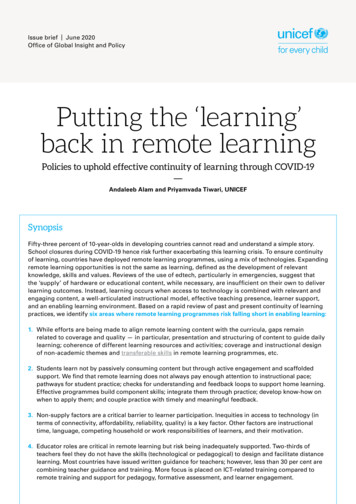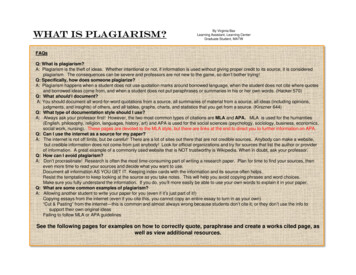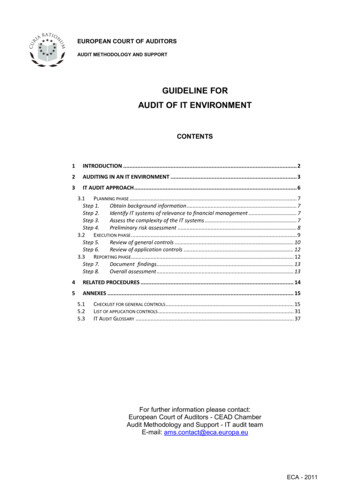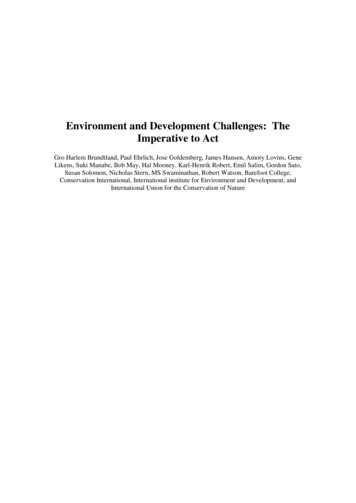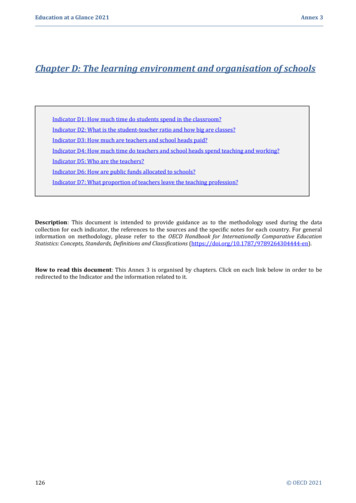
Transcription
Education at a Glance 2021Annex 3Chapter D: The learning environment and organisation of schoolsIndicator D1: How much time do students spend in the classroom?Indicator D2: What is the student-teacher ratio and how big are classes?Indicator D3: How much are teachers and school heads paid?Indicator D4: How much time do teachers and school heads spend teaching and working?Indicator D5: Who are the teachers?Indicator D6: How are public funds allocated to schools?Indicator D7: What proportion of teachers leave the teaching profession?Description: This document is intended to provide guidance as to the methodology used during the datacollection for each indicator, the references to the sources and the specific notes for each country. For generalinformation on methodology, please refer to the OECD Handbook for Internationally Comparative EducationStatistics: Concepts, Standards, Definitions and Classifications (https://doi.org/10.1787/9789264304444-en).How to read this document: This Annex 3 is organised by chapters. Click on each link below in order to beredirected to the Indicator and the information related to it.126 OECD 2021
Education at a Glance 2021Annex 3INDICATOR D1: How much time do students spendin the classroom? (Back to chapter D)OECDPartnersAustraliaAustriaFlemish Comm. (Belgium)French Comm. (Belgium)CanadaChileColombiaCosta RicaCzech RepublicDenmarkEngland ourgMexicoNetherlandsNew ZealandNorwayPolandPortugalScotland (UK)Slovak RepublicSloveniaSpainSwedenSwitzerlandTurkeyUnited StatesArgentinaBrazilChinaIndiaIndonesiaRussian FederationSaudi ArabiaSouth Africa OECD 2021D1MethodologySourcesParticipation in subnational data collectionMethodology and interpretation Organisation of the school US127
Education at a Glance 2021Annex 3General notesThe indicator on instruction time presents the intended recommended instruction time during compulsoryeducation (intended instruction time), and includes the compulsory and non-compulsory part of the curriculumthat students are entitled to receive in public schools.Indicator D1 focuses on compulsory primary and full-time lower secondary general education as defined inthe national education systems. Pre-primary education programmes and full-time upper secondary generaleducation, even if compulsory, are not within the scope of the Indicator. Figure X3.D1.1 presents an overview ofcompulsory education in the different countries by showing the number of years of compulsory education bylevel of education – for the school year 2020/21.Figure X3.D1.1. Compulsory general education, by level of education (2021)Note: The number in parentheses next to the country or economy name corresponds to the number of years of compulsory education.1. Additional three years for part-time vocational programmes.2. Additional two years of part-time compulsory education (pupils aged 16-18).3. Compulsory education is up to age 16, in the majority of jurisdictions in Canada (not specified as number of grades).4. Additional one year of compulsory pre-primary education in 17 states and the District of Columbia.5. Compulsory part-time education or training (obligation to participate in education or training) applies to 15-18-year-olds.Countries and economies are ranked in ascending order of the theoretical starting age of compulsory general education.Source: OECD (2021).Back to main table for this IndicatorOrganisation of breaks within the school yearInstruction time during the school year varies largely between countries, and this also impacts on the waycountries allocate annual instruction time over the year. To have an overview of the organisation of the schoolyear, Figures X3.D1.2 and X3.D1.3 presents the breaks planned during the school year (public/religious holidaysoutside the school breaks are excluded from these figures to ease the presentation).However, in the school year 2020/21, the school year schedule in some OECD and partner countries may nothave occurred as planned due to weeks of school closure by the COVID-19 pandamic. These information can befound in country-specific notes.128 OECD 2021
Education at a Glance 2021Annex 3Figure X3.D1.2. Organisation of the school year in primary education biaCosta RicaCzech bourgMexicoNetherlandsNew ZealandNorwayPolandPortugalSlovak iesFlemish Comm. (Belgium)French Comm. (Belgium)England (UK)Scotland (UK)PartnersRussian FederationJanFebMarAprStarting dateYear 2020MayJunJulFlexibilityAugSepHoliday (fixed or minimum)OctNovDecJanHoliday (maximum)FebMarAprMayYear 2021JunJulAugSepOctNovDecYear 2022JanFebMar1,234567891011Note: Excludes Brazil, Canada, Japan, Korea and the United States, where states and/or local jurisdictions are responsible for the organisation of the school year, resulting in variations between and amongjurisdictions. For Denmark and Iceland, the information refers also to lower secondary level.1. School year 2020 instead of 2021.2. Dates are indicative only as they vary according to the States and Territories. Private schools use similar dates but may vary from public schools.3. The start and end of the school year of the individual schools is according to the region (from 7 September 2020 to 2 July 2021 in Burgenland, Niederösterreich and Wien; and from 14 September 2020 to9 July 2021 in Kärnten, Oberösterreich, Salzburg, Steiermark, Tirol and Vorarlberg).4. Dates refer to Bogota territorial entity and are indicative only as variation between and among jurisdictions can occur.5. The start and end of the school breaks during the school year vary according to three areas (groups of académies - regional education authority).6. Dates refer to Nordrhein-Westfalen and are indicative only as variation between and among jurisdictions can occur.7. School year in the Hebrew education system (more than three-quarters of the total students). The organisation of the school year in the Arab and Druze education systems is different.8. The school year officially runs from 1 August to 31 July of the following year. The start and end of the school year of the individual schools is according to the region (Northern, Central and Southern region).9. The start date and end date of the school year can vary from school to school.10. Dates are indicative only as they vary according to the different Autonomous Communities.11. Dates are indicative only as they vary between schools.Source: OECD (2021) and European Commission/EACEA/Eurydice (2020). Back to main table for this Indicator OECD 2021129
Education at a Glance 2021Annex 3Figure X3.D1.3. Organisation of the school year in general secondary education biaCosta RicaCzech bourgMexicoNetherlandsNew ZealandNorwayPolandPortugalSlovak iesFlemish Comm. (Belgium)French Comm. (Belgium)England (UK)Scotland (UK)PartnersRussian FederationJanFebMarAprStarting dateYear 2020MayJunJulFlexibilityAugSepHoliday (fixed or minimum)OctNovDecJanHoliday (maximum)FebMarAprMayYear 2021JunJulAugSepOctNovDecYear 2022JanFebMar1,234567891011Note: Excludes Brazil, Canada, Japan, Korea and the United States, where states and/or local jurisdictions are responsible for the organisation of the school year, resulting in variations between and amongjurisdictions. For Denmark and Iceland, the information refers to upper secondary level only.1. School year 2020 instead of 2021.2. Dates are indicative only as they vary according to the States and Territories. Private schools use similar dates but may vary from public schools.3. The start and end of the school year of the individual schools is according to the region (from 7 September 2020 to 2 July 2021 in Burgenland, Niederösterreich and Wien; and from 14 September 2020 to9 July 2021 in Kärnten, Oberösterreich, Salzburg, Steiermark, Tirol and Vorarlberg).4. Dates refer to Bogota territorial entity and are indicative only as variation between and among jurisdictions can occur.5. The start and end of the school breaks during the school year vary according to three areas (groups of académies - regional education authority).6. Dates refer to Nordrhein-Westfalen and are indicative only as variation between and among jurisdictions can occur.7. School year in the Hebrew education system (more than three-quarters of the total students). The organisation of the school year in the Arab and Druze education systems is different.8. The school year officially runs from 1 August to 31 July of the following year. The start and end of the school year of the individual schools is according to the region (Northern, Central and Southern region).9. The start date and end date of the school year can vary from school to school.10. Dates are indicative only as they vary according to the different Autonomous Communities.11. Dates are indicative only as they vary between schools.Source: OECD (2021) and European Commission/EACEA/Eurydice (2020). Back to main table for this Indicator130 OECD 2021
Education at a Glance 2021Annex 3MethodologyThe joint Eurydice-OECD data collection on instruction time collects the intended recommended instructiontime during compulsory education (intended instruction time), and includes the compulsory and noncompulsory part of the curriculum that students are entitled to receive in public schools.The intended curriculum, its goals, structure, subjects and the notional workload for the pupils/students can bebased on regulations or standards of the central (or top-level) education authorities or may be established as aset of recommendations at regional level.The intended instruction time includes the time a public school is expected to provide instruction tostudents/pupils on all the subjects integrated in the compulsory and non-compulsory curriculum in the schoolpremises or in out-of-school activities which are formal parts of the compulsory programmes. The instructiontime excludes: breaks between classes or other types of interruptions, non-compulsory time outside the schoolday, time dedicated to homework activities, individual tutoring or private study, days when schools are closedfor festivities, such as national holidays, and days when students are not expected to be at school because ofteacher development days or student examination periods.All the respondents are asked to provide information on the instruction time in hours or periods, and per weeksor per year as stated in their national policy documents or defined in the national surveys. All the collectedinformation will be disseminated as annual instruction time in hours of 60 minutes per grade bearing in mindthe number of instruction days per week and per year and the number and length of periods.The subject areas taught during compulsory education vary depending on the country. It is therefore, necessaryto group them according to more general subject areas, in order to be able to compare the collected information.Table X3.D1.1 presents the subject categories that are included in the information gathering for the latest datacollection on instruction time (for the school year 2020/21 or 2021).Back to main table for this IndicatorTable X3.D1.1. List of study areas (subjects) used in the questionnaireTermDefinitionReading, writingand literature(Language 1)Covers skills such as spelling, reading, and writing in the language of instruction andincludes subjects such as grammar, language of instruction and literature. It can beconsidered as the first language taught to students. If there are two languages ofinstruction in almost every public school, then hours allocated to reading, writing andliterature in both languages of instruction should be reported.MathematicsNatural SciencesSocial SciencesSecond language(Language 2)Other languages(Languages 3-5)PhysicalEducation andHealthArts EducationReligion/Ethics/Moral education OECD 2021Covers all numeracy skills and subjects such as arithmetic, algebra, geometry, statistics,etc.Includes subjects such as science, physics, chemistry, biology, environmental sciences andecology.Includes subjects such as history, geography and all related studies. May also includecommunity studies, social and political instruction, philosophy or civics education.Includes subjects that develop students' knowledge of a language viewed in thecurriculum as “foreign” (or modern) languages, other national languages and/or regionaland minority languages. This definition of languages in the curriculum is educationallybased and unrelated to the political status of languages.Includes subjects such as education in sports and health enhancing physical activities, aswell as time devoted to instruction in competitive and traditional games, gymnastics,swimming, athletics, dance or other activities that develop pupils’ physical and socialcompetences (including knowledge, skills, psychomotor co-ordination, co-operation andleadership) and an active healthy lifestyle.Includes subjects such as arts, history of arts, music, visual arts, drama, music and danceperformance, photography, and creative handicraft.Includes subjects whose aim it is to teach the principles and history of one or morereligions and subjects such as ethics whose aim it is to determine how to live and behavein accordance with human and social principles.131
Education at a Glance 2021Annex 3TermDefinitionInformation andCommunicationTechnologies(ICT)Includes subjects such as informatics, information and communication technologies orcomputer science. These subjects include a wide range of topics concerned with the newtechnologies used for the processing and transmission of digital information, includingcomputers, computerised networks (including the Internet), microelectronics,multimedia, software and programming, etc.Practical andvocational skillsIncludes vocational skills (preparation for a specific occupation), accountancy,entrepreneurship education or business studies, career guidance clothing and textiles,driving and road security, home economics, nursing, secretarial studies, tourism andhospitality, woodwork, metalwork and sewingTechnologyOther subjectsCompulsorysubjects withflexible timetable(total timedevoted to )Compulsoryoptions chosenby the studentsCompulsoryflexible subjectschosen byschoolsNon-compulsorycurriculumIncludes subjects that provide knowledge on the practical use of scientific ortechnological discoveries that use specific instruments and processes. For example,construction, electricity, electronics, graphics and design, etc.Includes different subjects that cannot be classified within the other groups or whichspecifically reflect national concerns. The following types of subjects could be included inthis category: Latin, ancient Greek, classical studies, minority languages which are havenot been reported in Language 2, 3, 4 or 5 columns, environmental education, personaldevelopment and well-being.The “other subjects” must be part of the compulsory curriculum to be provided byschools. Form time, assemblies and tutoring should only be included if they arecompulsory, have an educational component and are aimed at all the students.Includes the total amount of instruction time indicated by the central authorities for agiven group of subjects, which regional authorities, local authorities, schools or teachersallocate to individual subjects. There is flexibility in the time spent on a subject, but not inthe subjects to be taught. For example, central authorities may define the total number ofhours that students should be studying reading, writing and literature, mathematics,science and modern foreign languages per year and schools may choose how to distributethis time between these individual subjects.Includes the total amount of instruction time on one or more subjects that pupils have toselect (from a set of subjects that are compulsory for schools to offer) in order to coverpart of their compulsory instruction time. This only applies if students have a choicebetween different subjects and not a choice within a subject category. For example,students may be able to choose between studying a second foreign language or computerscience or economics, but to attend one of these options is compulsory.Includes the total amount of compulsory instruction time indicated by the centralauthorities, which regional authorities, local authorities, schools or teachers allocate tosubjects of their choice (or subjects they chose from a list defined by central educationauthorities). For example, schools may be able to choose between offering religiouseducation or more science, or art, etc., but to offer one of these subjects is compulsory forthe school and students must attend it.Refers to the total amount of instruction time that public schools must offer on top of thecompulsory instruction time but is not mandatory for all students. Subjects can vary fromschool to school or from region to region and take the form of elective subjects.Additional activities before/after classes offered by the school are not per se part of noncompulsory curriculum, for instance, if there is no obligation upon public schools toprovide this instruction time or it is not part of the official curricula. In particular, noncompulsory education excludes additional activities such as morning care classes or afterschool care classes, even if they are officially regulated.Back to main table for this Indicator132 OECD 2021
Education at a Glance 2021Annex 3SourcesThe indicator draws on data from the 2020 Joint Eurydice-OECD Instruction Time data collection and refers tothe school years 2020/21 (or 2021). Sources of these data are displayed in Table X3.D1.2.In editions of Education at a Glance prior to 2014, data on instruction time was collected through the OECDNESLI data collection on Teachers and Curriculum with a different scope, methodology and definitions than the2013 Joint Eurydice-OECD instruction time data collection first published in Education at a Glance 2014. As aresult, data on instruction time may not be fully comparable with those published in previous editions ofEducation at a Glance. However, trend data on online database have been checked for consistency of trends.Table X3.D1.2. Sources and reference period (school year) for instruction timeCountrySources and nchComm.(Belgium)BrazilCanadaChileColombiaCosta RicaCzechRepublicDenmarkEngland (UK)Estonia OECD 2021Australian Curriculum, Assessment and Reporting Authority (ACARA)supported by state and territory government policy documents.Timetables in the curricula of Volkschule [primary school], Mittelschule[secondary school] and AHS (Allgemeinbildende höhere Schule) [academicsecondary school].Decrees and resolutions (Besluit van de Vlaamse Regering houdende deorganisatie van het schooljaar in het secundair onderwijs (31-08-2001); Besluitvan de Vlaamse Regering houdende de codoficatie betreffende het secundaironderwijs (17-12-2010); Decreet basisonderwijs (25-02-1997); Besluit van deVlaamse Regering tot organisatie van het schooljaar in het basisonderwijs en inhet deeltijds onderwijs georganiseerd of gesubsidieerd door de VlaamseGemeenschap (17-04-1991)).Directives officielles sur l'organisation de l'année scolaire :Circulaire n 7674 du 17 juillet 2020 relative à l'organisation de l'enseignementmaternel et primaire ordinaire – année scolaire 2020-2021 (link); Décret du 13juillet 1998 portant organisation de l'enseignement maternel et primaire etmodifiant la réglementation de l'enseignement; Circulaire générale n 7700 du 21août 2020 relative à l'organisation de l’enseignement secondaire ordinaire et à lasanction des études 2020-2021 (link); Loi du 19 juillet 1971 relative à la structuregénérale et à l'organisation de l'enseignement secondaire (article 8)Arrêté de l'Exécutif du 22 mars 1984 fixant le régime des vacances et des congésdans l'enseignement organisé dans la Communauté et calendrier scolaire 20202021 (link).National Education Law n. 9.394/1996 and Common National Curricular Base(Law 13,145, 2017); Exceptionally for 2020, Law n. 14.040/2020 (link; lastaccessed 23 November 2020).Estimates based on provinces/territories government policy documents andobservations. In some jurisdictions, that is informed by additions in CollectiveAgreements.Official curriculum and study programmes.Law 115 of 1994.Actual Instruction Time: Formal Education Survey C600 - DANE 2019.Guidelines on schedules for the different cycles, levels, offers and modalities ofthe Costa Rican educational system, 2015, Ministry of Public Education;Curricular Structures of all Modalities, III Cycle and Diversified Education,Directorate of Institutional Planning, 2010, Ministry of Public Education;Transfer of Agreement 34-97, May 1997, Higher Council of Education; SchoolCalendar 2016. Ministry of Public Education; Human Resources Department,Ministry of Public Education.Framework Curriculum Timetable set by the Framework EducationalProgramme for Basic Education (FEP BE).Act on the Folkeskole: Bekendtgørelse af lov om folkeskole (link),Intended instruction time (link1) (link2).Department for Education (link).Basic schools and Upper Secondary Schools Act; The national curriculum forbasic 33
Education at a Glance 2021CountrySources and referencesFinlandBasic Education Act (628/1998) (link); Decree (852/1998);Valtioneuvoston asetus perusopetuslaissa tarkoitetun opetuksenvaltakunnallisista tavoitteista ja perusopetuksen tuntijaosta (Government Decreeon the General National Objectives and Distribution of Lesson Hours in BasicEducation) (422/2012); Valtioneuvoston asetus perusopetuslaissa tarkoitetunopetuksen valtakunnallisista tavoitteista ja perusopetuksen tuntijaosta annetunvaltioneuvoston asetuksen 6 §:n muuttamisesta (793/2018) (Government Decreeamending Article 6 of the Government Decree on the General NationalObjectives and Distribution of Lesson Hours in Basic Education.Temps scolaire (pour les jours fériés) (link).Grade 1-5: Décret n 2013-77 du 24 janvier 2013 relatif à l'organisation du tempsscolaire dans les écoles maternelles et élémentaires (link) ; Arrêté du 9 novembre2015 fixant les horaires d'enseignement des écoles maternelles et élémentaires(link).Grades 6-9: Décret n 2015-544 du 19 mai 2015 relatif à l'organisation desenseignements au collège (link) ; Décret n 2016-1063 du 3 août 2016 relatif àl'organisation de la journée scolaire au collège (link) ; Arrêté du 19 mai 2015relatif à l'organisation des enseignements dans les classes de collège (link) ;Arrêté du 19 mai 2015 modifié relatif à l'organisation des enseignements dans lesclasses de collège (link).Grade 10: [Accompagnement personnalisé au lycée] Arrêté du 16 juillet 2018relatif à l'organisation et aux volumes horaires de la classe de seconde des lycéesd'enseignement général et technologique et des lycées d'enseignement général ettechnologique agricole (link).Information provided by the Ministries of Education and Cultural Affairs of theLänder.[Legislation on Primary Education] Ministerial DecisionΦ12/657/70691/Δ1/26-04-2016, G.G. 1324/B/2016, as modified by (a)Presidential Decree 79/2017 par. 1, ch. Α, art. 11, G.G. 109/Α/1-8-2017, (b) Law4559/2018, art. 23, G.G. 142/A/2018, (c) Law 4589/2019 art. 79, G.G13/Α/2019, and (d) Law 4692/2020, art. 3 G.G. 111/A/2020; [Legislation onLower Secondary Education] Provisions on organisation issues of school life insecondary schools: Ministerial Decision 79942/ΓΔ4/21-5-2019 (G.G.2005/B/2019) as modified and in use. [Daily Timetable of Grades A, B, C in DayLower Secondary Schools] Ministerial Decision 72322/Δ2/11-06-2020(G.G.2265/issueB/2020); [Remedial courses in lower secondary schools]Ministerial Decision 125614/Δ2/21-9-2020 (Government Gazette4194/B/2020), and Ministerial Circular 192635/Δ2/06-12-2019. MinisterialCircular 190790/Δ7/04-12-2019 on programmes for school activities(projects); [Information on the percentage of students following the reportedintended curriculum] Information system Myschool.The Ministerial Decree No 27/2020 (VIII. 11.), the National Core Curriculumand the related Framework curricula.National Curriculum Guidelines for Compulsory School 2011. CompulsorySchool Act nr. 91/2008, Chapter 8 The Icelandic National Curriculum Guidelinesfor Compulsory Schools with Subject Areas, pages 49-52 (link).Primary: Circular 11/95, Sections 2 and 3, available at www.education.ie.Guidance on time provision is also provided in the “Introduction to the PrimaryCurriculum” (1999) under the heading “The Suggested Minimum Weekly TimeFramework” (p. 70), available at www.ncca.ie. Primary circular letter0061/2015 and National Strategy: Literacy and Numeracy for Learning and Life(2011-2020) available at www.education.ie.Secondary: Circular M29/95, Sections 2 and 3. Rules and Programme forSecondary Schools. Framework for Junior Cycle (2015). Circular 0055/2019 andCircular 79/2018 Arrangements for the Implementation of the Framework forJunior Cycle with particular reference to school years 2019/20 and 2018/19.Circular 76/2020 Arrangements for the Implementation of the Framework forJunior Cycle with particular reference to school year 2020/21. All referencedocuments for lower and upper secondary levels are available ndIreland134Annex 12020/212020/21 OECD 2021
Education at a Glance 2021CountrySources and referencesIsraelProfessional units of the Ministry of Education and Guidelines General ManagerPublications curriculum in schools and for the hour’s allocations.Decree of the President of the Republic (DPR) 275/1999 on school autonomy;Organisation of the primary and lower secondary school levels and the relevanttimetables: DPR 89/2009; Minimum weekly timetable at primary level: Law169/2008; Organisation of Licei (general upper secondary level): DPR 89/2010.The Enforcement Regulation for School Education Act; The National CurriculumStandard for Elementary Schools; The National Curriculum Standard for LowerSecondary Schools; The curriculum formulation and implementation survey forpublic primary and lower secondary schools (2018).Ministry of Education. Primary and Secondary School Curriculum Overview(2015 Revision).National Standard for Basic Education and Standards for Basic EducationSubjects, and Basic Education Sample Plans (2014) (link); The GeneralEducation Law (link); Regulation on National Basic Education Standards andSamples of Basic Education Programmes (2018) (link).General Teaching Plan for the Primary Education Curriculum 2019-2020 and2020-2021, No V-413, 15 April 2019 (link); General Teaching Plans of the Basicand Upper Secondary Education Curricula for 2019-2020 and 2020-2021, No V417, 15 April 2019 (link).Ministère de l'Éducation nationale, de l'Enfance et de la Jeunesse.Grades 1-6 : Plan d'études de l'enseignement fondamental.Grades 7-10 : Grille horaire de l'enseignement secondaire/secondaire technique.Secretaría de Educación Pública (SEP), Plan de estudios 2011, Educación básica,2011, México (link).Upper secondary education (National School System): Mapa Curricular conEnfoque Educativo en Competencias, page 37 (link).Law on Primary Education (WPO) and Law on Secondary education (WVO).Education Act 1989.Law and policy document based on law - subject syllabuses: Circular Udir-012020.The School Education Act of 7 September 1991 (with further amendments);Regulation by the Minister of National Education of 3 April 2019 on outlinetimetables in public schools; Regulation by the Minister of National Education of11 August 2017 on the organisation of the school year; Regulation by theMinister of National Education of 14 April 1992 on the conditions andprocedures for teaching religion in public schools; Regulation by the Minister ofNational Education of 12 August 1999 on teaching at school and scope ofcontent for knowledge on human sexual life, rules for conscious and responsibleparenthood, value of family, life in its prenatal form, and methods and tools forconscious procreation included in the core curriculum for general education;Regulation by the Minister of National Education of 2 June 2017 amending theregulation on teaching at school and scope of content for knowledge on humansexual life, rules for conscious and responsible parenthood, value of family, lifein its prenatal form, and methods and tools for conscious procreation includedin the core curriculum for general education; Regulation by the Minister ofNational Education and Sport of 31 December 2002 on safety and hygiene inpublic and non-public schools and institutions (with further amendments);School Education Information System database (System Informacji Oświatowej).Decree-Law no. 55/2018, of July 6th, Ministerial implementing order no. 223A/2018, of August 3rd; Ministerial implementing order no. 226-A/2018, ofAugust 7th, Legislative Order no. 6906/2020, 3rd urgMexicoNetherlandsNew nd (UK) OECD 2021Scottish Curriculum for Excellence; Education (Scotland) Act 1980; Children andYoung People (Scotland) Act 2014.Annex 20/212020/212020
Chapter D: The learning environment and organisation of schools Description : This document is intended to provide guidance as to the methodology used during the data collection for each indicator, the reference
